On the Origins of New Forms of Life
9.3: Pangolins and Armadillos
(Continued from the previous page)
A taxonomic category containing a variety of forms is often named for a particular form that it contains. Thus, among dinosaurs, the iguanodontids are named for Iguanodon, the tyrannosaurids for Tyrannosaurus, the stegosaurids for Stegosaurus. Likewise, the ankylosaurs are named for the four-ton Ankylosaurus, which lived in the latest Cretaceous.¹ Numerous other ankylosaurs existed, ranging down to Struthiosaurus, about the size of a human being.² Ankylosaurs were among the most common large animals of the Cretaceous, but fragmentary remains indicate that similar forms existed already at least as early as the lower Jurassic, for example, Sarcolestes.³ Known from every continent except Antarctica,⁴ all ankylosaurs were armor-clad. In addition, some had a tail tipped with a heavy mass of bone that could be whipped from side to side with potentially lethal effect. Paleontologists have classified ankylosaurs as dinosaurs, and assert that they died out at the end of the Cretaceous. But is this so?
The extant giant armadillo (Priodontes maximus) is widespread in South America.⁵ Compare Priodontes (Figure 9.1a) with a typical reconstruction of the Cretaceous ankylosaur, Nodosaurus (Figure 9.1b). VIEW ADDITIONAL PICTURE OF PRIODONTES Allowing for the vagaries of reconstructing the appearance of an organism from fossils, Nodosaurus appears quite similar to Priodontes. However, accepted theory would, almost certainly, account for the observed similarity between ankylosaurs and the giant armadillo, not in terms of genetic relationship, but by referring to "gradual adaptation to similar environments." But, if armadillos started evolving from a "small, primitive, generalized" placental mammal after ankylosaurs died out, this process of "adaptation" must have been rapid indeed. The ancestors of Priodontes can be traced through the fossil record all the way back to the Paleocene,⁶ immediately after the ankylosaurs are said to have gone extinct.
A "giant" armadillo (Priodontes) is not even quite as large as the smallest known ankylosaur (Struthiosaurus). But much larger armadillos (glyptodonts), now extinct, survived long enough to be hunted by the pre-Columbian peoples of South America only a few thousand years ago.⁷ Glyptodonts the size of a small car survived into the late Pleistocene (e.g., Glyptodon). Such animals were about the size of Ankylosaurus itself, the largest of the ankylosaurs (the Pleistocene ended only about 10,000 years ago). VIEW A PICTURE OF A GLYTODONT Like certain ankylosaurs, some of these giant armadillos had tail clubs. In both ankylosaurs and armadillos, these clubs could be armed with long, bony spikes.⁸
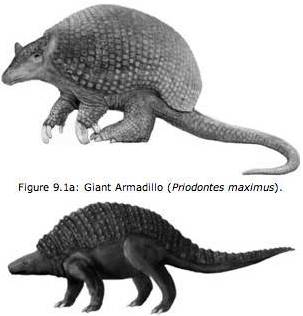 Fig. 9.1b: Reconstruction of Nodosaurus
Fig. 9.1b: Reconstruction of NodosaurusVideo: Priodontes
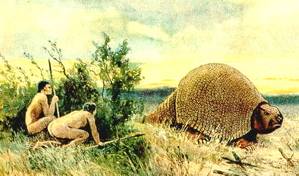 Artist's rendering of Glyptodon
Painter: Heinrich Harder
Artist's rendering of Glyptodon
Painter: Heinrich Harder
These observations suggest that paleontologists have created an artificial distinction by classifying Mesozoic "ankylosaurs" as reptiles and post-Mesozoic armadillos as mammals. Given available evidence, and given stabilization theory's assumption that new types of organisms typically arise from precursor forms similar to themselves, the obvious conclusion seems to be that the various forms described as armadillos of the "Age of Mammals" (the Cenozoic Era) are descended from the various forms described as ankylosaurs of the "Age of Reptiles" (the Mesozoic Era).
The wide acceptance of the notion that ankylosaurs are reptiles can be attributed to two factors:
-
most paleontologists specializing in dinosaurs are unlikely to be familiar with the specifics of armadillo anatomy (which is, in fact, poorly known compared to that of most mammals);
and - the categorization of armadillos as mammals is based on soft anatomy (armadillos give live birth, nurse their young, are warm-blooded, and have hair to a greater or lesser degree in addition to their scales). Such traits are rarely or never seen in fossils.
But the reasoning of stabilization theory suggests the various forms described as ankylosaurs, too, had the soft traits of a mammal, since their hard anatomy is so similar to that of armadillos. But, if such is the case, what about other Mesozoic "reptiles" similar to ankylosaurs (members of Order Ornithischia)? Are some of these, too, mammals on masquerade?
Incredibly, this seems likely to be the case with one of the most famous "dinosaurs," Stegosaurus, an animal usually considered closely related to the ankylosaurs. According to Bakker (1986: 187), "Stegosaurus and its close kin were the only common large, beaked dinosaurs in the late Jurassic." Stegosaurids became rarer through the Cretaceous as the ankylosaurs became more numerous, but are known even from the end of that period.⁹,¹⁰ The familiar image of Stegosaurus shows a creature with spikes tipping its tail and upright angular plates sheltering its spine. The small inset in Figure 9.2 (below) depicts a typical museum reconstruction of this animal. But this reconstruction of the living animal is uncertain — articulated stegosaurid remains have never been found.¹¹ As Dixon et al. (1988: 156) point out,
No one is certain exactly how the bony plates were arranged on the back of Stegosaurus. Although many well preserved specimens have been found … the plates have never been found actually attached to the skeleton. Some paleontologists maintain that they lay flat in or on the skin, and formed a defensive armor over the back and upper flanks.
This alternative viewpoint has interesting implications. Suppose (1) the plates actually did lie flat on the skin in an overlapping fashion (which would certainly seem to afford better protection against predators); and (2) the "tail" spikes were not on the tail, but instead were huge claws on the feet. How would such an animal look? Clearly, it would closely resemble extant pangolins (see Figure 9.2).
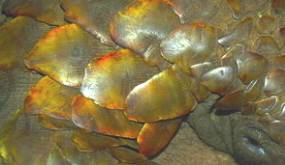
|
| Pangolin scales: Shaped like the plates of stegosaurids. Photo: Marc Eschenlohr |
The pangolins, or scaly anteaters, are classified as mammals (Order Pholidota). Nevertheless, the back, upper flanks, and the outer surfaces of a pangolin's legs are covered with large scales similar in shape to the armor plates of a stegosaurid. Several different kinds of pangolins are extant. A Giant Pangolin (Smutsia gigantes) is pictured in Figure 9.2. In the figure, note that although only a portion of each scale shows (because each is mostly covered by the ones that overlap it), the scales of a pangolin are actually about as large in proportion to body size as are a stegosaurid's armor plates. A pangolin's scales are attached to the skin, not the skeleton and can bristle because they are attached only at one end. For this reason, one would not expect them to remain in place in a fossilized animal. They would detach after death as the skin decomposed. Known stegosaurid remains are so severely disarticulated that it is not even certain how many scales they had. The supposed tail spikes of stegosaurids are about as large in proportion to body size as are the huge claws of a pangolin (see Figure 9.2). In stegosaurids, also, these spikes (claws?) may well have been attached to the feet, and not the tail.
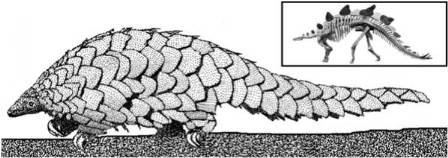
|
|
Figure 9.2 Main figure: Giant Pangolin (Smutsia gigantes). Inset: A typical reconstruction of the familiar Stegosaurus. Note that the shape of
the pangolin's scales, and their size in proportion to body size, are like those of the animal shown in the inset (in a pangolin's armor about half of each scale is hidden by overlap). Observe, too, on the pangolin's feet, the presence of large claws that, in reconstructions of supposed stegosaurids, have perhaps been misinterpreted as tail spikes (see text). |
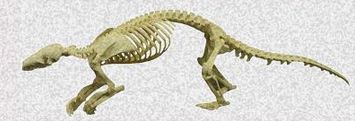
|
| Pangolin skeleton |
The overall form of a pangolin, too, is similar to that of a stegosaurid — a long thick tail, highest point at hips, nose to ground. The proportion of the limbs is also similar. A pangolin's skull, which bears little resemblance to that of other living mammals, is quite similar to that of a stegosaurid.¹² Pangolins have no teeth.¹³ Even in large stegosaurids, the jaws are weak and the teeth are tiny and ineffectual. Stegosaurids apparently used gizzards to grind their food.¹⁴ The presence of a gizzard is not usually considered a mammalian trait, but pangolins do possess this organ.¹⁵ Giant armadillos and most types of pangolins share a similar lifestyle. Most are nocturnal, burrowing forms. According to Walker (1983), the diet of the giant armadillo
Pangolins also feast on such fare. Both armadillos and pangolins use their heavy claws to rip into termite mounds, anthills, and carcasses and then, with their long, protrusible tongues, lap up their dinners.¹⁶
Various types of pangolins exist, distributed over much of the tropical world, from West Africa to Borneo.¹⁷ Fossil forms are known, too, from North America.¹⁸ Fossils recognized as pangolins date to as early as the Paleocene,¹⁹ just after stegosaurids supposedly went extinct.²⁰ The largest living pangolin is about two meters long,²¹ the smallest known stegosaurid (Kentrosaurus), measures about two and a half meters.²²,²³ Similarly, the length of the largest extant armadillo is about two meters,²⁴ while the smallest ankylosaur known (Struthiosaurus) measured two meters.²⁵ As has already been mentioned, huge armadillos, probably exterminated by humans, survived in South America until a few thousand years ago.
The modern giant armadillo is so similar to the ancient ankylosaurs that it is only reasonable to suppose it is descended from them. The same is true for pangolins and stegosaurids (although the case is somewhat weaker because the exact external form of stegosaurids is a point in dispute). These similarities strongly suggest that two of the most common "dinosaurs" of the so-called Age of Reptiles — ankylosaurs and stegosaurids — were in fact mammals, and, even more remarkably, that their direct descendants exist even today. So in their cases, it seems, there was no "extinction of the dinosaurs" — there was merely a reconceptualization and reclassification (both may be cases of residual dwarfism). If so, then the diet of stegosaurs and ankylosaurs was probably not herbaceous, as has been conjectured. The diets of their modern counterparts would suggest that they were primarily insectivores that also ate small vertebrates and carrion. Their jaws completely lack the grinding teeth needed to process tough plant material. They probably used darting tongues to feed on insects and small vertebrates then ground them in a gizzard.
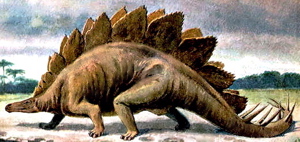
|
| Artist's rendering of Stegosaurus - Is it just imagination? Painter: Heinrich Harder |
The apparent mammalian status of stegosaurs and ankylosaurs seems also to contradict the idea that Cretaceous mammals were small (since many forms in these two categories were huge animals). Moreover, if the ankylosaurs and stegosaurids were placental mammals, as are their apparent modern counterparts, then the placental mode of reproduction must date to a far earlier date (at least to the early Jurassic) than that generally proposed in the mammalian radiation dogma, according to which the first placentals appeared in the late Cretaceous (about a hundred million years later). Such findings raise the suspicion that at least some of the other members of Ornithischia, the "reptilian" order containing ankylosaurs and pangolins, may turn out to be mammals, too, since the bony structure of other ornithischians is similar to that of ankylosaurs and stegosaurids.
Nevertheless, accepted theory says simply that armadillos and pangolins evolved from "small, primitive, generalized" placental mammals living late in the Cretaceous, and that they have nothing whatever to do with dinosaurs. Presumably a neo-Darwinian would account for the near identical appearance of modern giant armadillos and ancient ankylosaurs by ascribing it to "adaptation to similar niches." This is implausible — armadillos appear in the fossil record right after "ankylosaurs" supposedly went extinct. The only clear distinction between the two is that the fossil animals we call ankylosaurs lived in the "Age of Reptiles," while the ones we call armadillos lived in the "Age of Mammals."
It may be this tendency to categorize on the basis of time simply reflects a lingering bias among biologists. Some attention has already been given to the influence of the scala naturae on biological thought. In its classical conception, the scala was simply a static ordering of beings, from "lowest" to "highest." Early evolutionary thinkers temporalized this concept by asserting that "lower" biological forms arose at an earlier date, and "higher" ones arose at a later date. Thus, the relative positions of the various animal forms in the old, static hierarchy gave rise to a particular temporal ordering of the story told about evolution. Briefly, this story said the order of appearance was (1) invertebrates, (2) fish, (3) amphibians, (4) reptiles, (5) birds, and (6) mammals.
Even today, this viewpoint seems to contribute to habits of thought that tend to bias the way scientists talk about fossils. In particular, the idea that mammals are "higher" and that they came after reptiles seems to dispose paleontologists to call very similar animals (e.g., ankylosaurs and giant armadillos) by different names and to make very different claims about their natures (i.e., that one is a reptile and the other a mammal). Another example is seen in the ease with which biologists accept the idea that synapsids were reptiles. If synapsids were classified as early mammals (as might seem reasonable on the basis of their hard anatomy), the earliest known mammals would then be the contemporaries of the earliest known reptiles. NEXT PAGE >>
Notes (Works Cited):
1. Farlow and Brett-Surman (1997).
2. Dixon et al. (1988: 160–161); Weishampel et al. (1990).
3. Norman (1985).
4. Romer (1966: 370); Weishampel et al. (1990: 475).
5. Walker (1983).
6. Barlow (1984); Savage and Russell (1983: 46).
7. Fidalgo et al. (1986); Politis and Gutierrez (1998).
8. Dixon et al. (1988: 209); Romer (1966: 161); Weishampel et al. (1990).
9. Norman (1985: 154).
10. For example, Dravidosaurus.
11. Weishampel et al. (1990: 454).
12. Anderson and Jones (1984). It seems likely that many of those differences that do exist between their skulls may be attributed to allometric changes since "stegosaurid" skulls are so much larger than those of extant pangolins.
13. Walker (1983: 470).
14. Dixon et al. (1988: 156); Norman (1985: 154).
15. Bakker (1986); Dixon et al. (1988: 156).
16. Walker (1983: 470).
17. Walker (1983).
18. Emry (1970); Fox (1991); Rose et al. (1977); Savage and Russell (1983).
19. Norman (1985: 153).
20. Norman (1985: 152) notes that stegosaurids have been found in latest Cretaceous strata.
21. Walker (1983: 470).
22. Norman (1985: 153).
23. Perhaps most of the giant stegosaurid/pangolins died out at the end of the Cretaceous, while the smaller forms lingered on. Burrowing, which is a trait associated with small body size (Auffenberg 1962; Auffenberg and Weaver 1969; McNab 1980), may have helped the smaller stegosaurid/pangolins to survive the catastrophic effects of the K-T asteroid impact. Fossil evidence proves the former existence of larger (8-foot) pangolins (Manis paleojavanicus) from Borneo and Java. These appear to have died out in the late Pleistocene (Flannery 1995), which ended only about 10,000 years ago. Unconfirmed reports say a horse-sized pangolinlike animal, the "veo," still exists on the Indonesian island of Rintja (Pfeiffer 1963; Shuker 2003: 264–265). Cryptozoologists suggest the veo may be a relict population of M. paleojavanicus.
24. Norman (1985: 153).
25. Dixon et al. (1988: 160).
Most shared on Macroevolution.net:
Human Origins: Are we hybrids?
On the Origins of New Forms of Life
Mammalian Hybrids
Cat-rabbit Hybrids: Fact or fiction?
Famous Biologists
Dog-cow Hybrids
Georges Cuvier: A Biography
Prothero: A Rebuttal
Branches of Biology
Dog-fox Hybrids